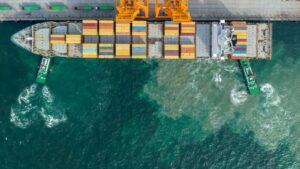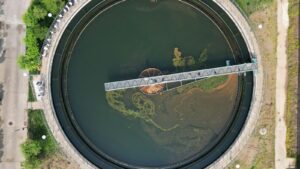Proactive Stormwater Management and Flood Resilience
Proactive Stormwater Management and Flood Resilience
Climate change is reforming entire weather patterns and intensifying rainfall globally. These changes lead to more frequent and severe floods. We cannot stop rain from falling, but we can change the way our cities interact with stormwater that leads to flooding. The key idea is to adapt to our changing ecosystems instead of allowing floods to destroy cities.
The current approach to flooding is reactive, leading to billions of dollars in preventable damage occurring every year. Combinations of sensor technology and advancements in artificial intelligence (AI)/machine learning (ML) and risk analysis modelling, provide access to insights that were previously too costly (rapid infrastructure analysis with AI image recognition) or impossible to predict (localized predictive flood mapping and impact to infrastructure).
Holly Stower and Zainab Gilani of Cleantech Group discuss water resilience and adaptation- what it means and the different areas of focus within those terms.
Flood Resilience Technologies
Proactive approaches to flooding are 5x more effective. Increasing the specificity of innovation and the granularity of data in the flood technology sector allows cities to analyse impacts of flooding and act on pressing issues with surgical precision.
The three key technology areas are:
- Physical Solutions to prevent flood or reduce damage, e.g., artificial reefs to slow coastal erosion, alternative concrete to improve cities’ concrete ability to drain stormwater, and low-carbon concrete seawalls/reefs.
- Sensors to remotely measure water flow, rainfall and detection of blockages, sometimes in real-time.
- Software: Analytical tools to layer, meaning to sensor data, e.g., AI tools detect faulty infrastructure through video while ML tools provide precise predictions and locations on how floods will impact infrastructure.
For asset owners and governments, pressure is mounting to find quick solutions to both a changing climate and failing infrastructure. While companies are innovating in this space and improving how cities and coasts deal with erosion and pluvial (stormwater) flooding, the technologies are severely undervalued.
Technological competition between companies is high in these markets but most solutions are limited in how fast they can scale by geographic constraints, the localization of data and cost of production. This leads to a fragmented market with many companies offering the same solutions and hoping to scale faster than competitors. For this reason, venture capital firms have focused investment on companies with scalable products and minimal competition.
The primary customers for adaptation solutions in water are governments. A handful of companies have managed to tap into public funds through grants, research pilots, and development partnerships with incumbents (insurers, construction, and engineering). Private funding has been low but could grow rapidly as these technologies are proven out, and as climate risks increase alongside asset exposure.
Flood Resilience Innovator Spotlight
- Previsico: The UK developer of flood mapping and insurance risk assessment software raised $2.4M in seed funding. In 2022, Previsico won a contract in Northern Ireland and is now using its funding to target international growth in the American northeast. Traditional flood forecasting ignores pluvial flooding, which accounts for 70% of total flooding damage.
- PaveDrain: The American developer of permeable concrete that stimulates natural water tables allows stormwater to penetrate the ground instead of accumulating above ground. PaveDrain is targeting older, flood-prone cities as partners to show tangible benefits of their product, with highly successful pilots and retrofits in Milwaukee, Athens, Cincinnati, Richmond, and Newark, that have dramatically reduced flooding incidents.
- SewerAI, The American developer of AI image recognition technologies remotely identifies sewer and stormwater infrastructure defects, to reduce repair cost and assessment time for city governments. SewerAI raised $6M in a Series A in April 2022, followed by an additional $3M in growth equity this month.
What Types of Companies are Combatting Flood Resilience?
Start-ups: Three primary areas where start-ups are innovating are in software, hardware, and physical solutions with each having an interesting competitive dynamic:
- Software is focused on the use of AI but requires scale and significant data for AI benefits to be realized. Most risk mapping companies do the same thing in different geographies. Some stand out because they tackle unique issues in infrastructure, e.g., SewerAI and CivilGrid.
- Hardware (sensor) companies are thriving and providing sensors to software companies or moving into the software space themselves. They enjoy the most developed and healthy market of the three.
- Physical solutions have the largest potential market but fold easily due to high competition and investment costs. Government partnerships here are essential.
Incumbents: Global or nationwide engineering companies are not actively engaging the start-up market to acquire flood adaption technologies. Instead, they are mainly contracting with physical solution providers like ARC Marine when the product fits their project needs. Large construction companies like AECOM and Jacobs were more active in acquiring start-ups and their technologies prior to 2020. Since then, they have invested heavily in creating their own internal tools or replicating successful start-ups.
Flood Resilience’s Trends and Long-Term Outlook
Successful companies enter the market with strategic partnerships, primarily with channel partners and government relationships, as these are their primary customers (e.g., Previsico). A similar trend that helps with scaling is an ability to create software models that are both granular at the local level but transferable to different geographic areas (e.g., SewerAI).
A promising path toward rapid modernization of flooding infrastructure is through companies that can tackle entire geographic markets at once, e.g., AECOM addresses flood mapping and provides digital tools for the entire American northeast. The physical solutions and software markets are intensely competitive and very technologically undervalued.
The ultimate winners will have to bear heavy costs and risks to succeed, and they will have to secure government partnerships. Funding is growing slowly but steadily and providing an optimistic outlook for the adaptation sector, but the funds need to be more pointed in how and where they will be implemented and ultimately how they will fit into city-wide, state-level, and national plans for flood adaption.



